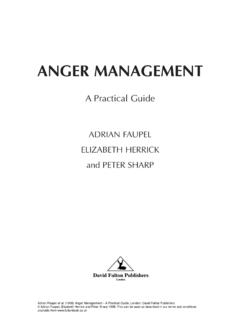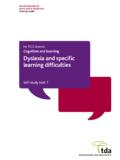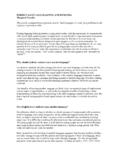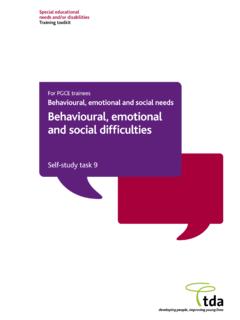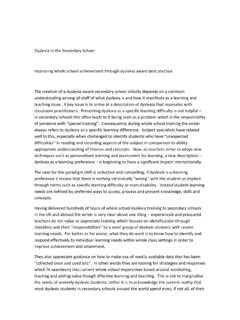Transcription of Status: Recommended with dyslexia and Date of …
1 Guidance The National Numeracy Strategy Curriculum & Standards The daily mathematics lesson Teachers and Guidance to Teaching Assistants in Primary Schools support pupils Status: Recommended with dyslexia and Date of issue: 09/01. Ref: DfES 0512/2001. dyscalculia Standards and Effectiveness Unit 2+3 GUIDANCE TO SUPPORT PUPILS WITH dyslexia AND DYSCALCULIA. 18-7. 12 2 dyslexia and dyscalculia 1 2. 3+ dyslexia 2 1 dyslexia is a condition that affects the ability to process language. Dyslexic learners often have difficulties in the acquisition of literacy skills and, in some 33+5 cases, problems may manifest themselves in mathematics.
2 It is not surprising that those who have difficulties in deciphering written words should also have 66 3 difficulty in learning the sets of facts, notation and symbols that are used in mathematics. This pattern of abilities and weaknesses is known as specific 7 3 learning difficulties'. 41+3. Problems often occur with the language of mathematics, sequencing, orientation and memory, rather than with the mathematics itself. Dyslexic learners find it 19-5 difficult to produce mental or written answers quickly, and the need to learn by heart' for pupils who have poor memory systems may well result in failure and 2 3 lack of self-belief.
3 Some dyslexic learners will enjoy the flexibility of approach 3 2 and methods while, for others, choice creates uncertainty, confusion and anxiety. 1. 42 0. 12+2. 192 . 4. 77+6. 11 0. 23+3. 58- 9. 42+2. +2 Dyscalculia 72 Dyscalculia is a condition that affects the ability to acquire arithmetical skills. Dyscalculic learners may have difficulty understanding simple number concepts, 332+4 lack an intuitive grasp of numbers, and have problems learning number facts 2 2 and procedures. Even if they produce a correct answer or use a correct method, they may do so mechanically and without confidence. 1 7 + 2 Very little is known about the prevalence of dyscalculia, its causes, or treatment.
4 Purely dyscalculic learners who have difficulties only with number will have 199 2 cognitive and language abilities in the normal range, and may excel in non- mathematical subjects. It is more likely that difficulties with numeracy accompany 18 2 the language difficulties of dyslexia . 0+2 2. GUIDANCE TO SUPPORT PUPILS WITH dyslexia AND DYSCALCULIA 2+3. 18-7. How do pupils with 12 2. 1 2. dyslexia and dyscalculia 3+. learn mathematics 2 1. 33+5. differently? Numbers and the number system 66 3. Dyslexic learners: 7 3. often have difficulty counting objects. This affects basic number sense'. They need clear instructions on how to 41+3.
5 Count in an organised, meaningful way. They should count objects frequently, 19-5. move objects as they count, count rhythmically to synchronise counting words with counting objects, and pause to take in' the quantity counted. 2 3. may have difficulty processing and memorising sequences. 3 2. Dyslexic learners may be slow to learn a spoken counting sequence. Counting 1. backwards is particularly difficult. They need additional practice in counting orally and need to continue oral counting into higher value sequences. Support can be 42 0. provided by presenting sequences such as , , __, __, as , , __, __, , 12+2. The use and recognition of pattern is important and can be used to circumvent 192.
6 Some of the problems with memory. Dyslexic learners need support counting 4. through transitions, 198, 199, 200, 201 or 998, 999, 1000, 1001, and practice structuring from one count to another, from counting in tens to counting in ones. 77+6. may find the underlying structure of the number system difficult to grasp. 11 0. Dyslexic learners find completed 100-grids difficult to process and understand, failing to visualise or grasp the significance of the number 23+3. patterns. Working with 91 92 93 94 95 96 97 98 99 100. 58- 9. practical' versions of a 100-grid can facilitate 81 82 83 84 85 86 87 88 89 90 42+2. understanding, working +2.
7 72. 71 72 73 74 75 76 77 78 79 80. with a 100-bead frame, or 61 62 63 64 65 66 67 68 69 70. counting estimated quantities into a 100-frame 51 52 53 54 55 56 57 58 59 60 332+4. formation before moving on to 1 100 grids. Some 41 42 43 44 45 46 47 48 49 50 2 2. 2. pupils benefit from grids 31 32 33 34 35 36 37 38 39 40. that have 1 to 10 across the 21 22 23 24 25 26 27 28 29 30 1 7 +. bottom row so that the numbers get bigger as one 11 12 13 14 15 16 17 18 19 20 199 2. 18 2. moves up the grid. 1 2 3 4 5 6 7 8 9 10. 3 0+2. 2+3 GUIDANCE TO SUPPORT PUPILS WITH dyslexia AND DYSCALCULIA. 18-7. 12 2 find the interval-based structure of a number line difficult to 1 2 understand.
8 3+ Many dyslexic learners make better progress if they work with practical versions of number tracks' first, a 100-bead string. Estimated quantities 2 6 may be counted into tens-structured tracks, 33+5 66 3. 7 3. 41+5 Quantities structured in this way are easily rounded'. 19-5 Follow-up work on number lines should highlight number structures. For example, on a line to 100, the decades should be clearly demarcated. Pupils 2 3 with learning difficulties also benefit from work on emptier' lines and emptier'. 2. materials, such as counting stacks. Such materials support the rounding of 1 3 numbers. need extra support in counting forwards and backwards.
9 42 0 Use a clearly labelled number line, or counters placed in recognisable clusters, 12+2 as on dominoes. Teen numbers are an example of the inconsistencies of our number system. For example, thirteen should be ten three, but it is said and 192 . 4 written as three and ten. By contrast, the word twenty-three is in the same order as the digits, even if twenty is an irregular word (compared to two hundred). Careful teaching can minimise these difficulties as well as introduce the more 77+6 regular pattern of larger numbers sixty-six, seventy-six, etc. 11 0 Dyslexic learners may find the transfer of a learned sequence, say 90, 80, 70.
10 , to a modified sequence 92, 82, 72 .., challenging. Base ten blocks or 23+3 coins may help illustrate which digit changes and which remains constant. 58- 9 often have difficulties understanding place value. Language uses names to give values when counting (ten, hundred) while 42+2 numerals use the principle of place value the relative places held by each +3 digit in the number (10, 100). Pupils who have not mastered the name value 72 system may say that nine hundred and ninety-nine is bigger than one thousand. Language demands are greater in writing numbers in words. Numbers that 332+4 feature zeros, such as 5006, will need careful teaching, using practical 2 2 materials and focusing pupils on the top value' word: five thousand and six has four digits because the top word is thousand'.
